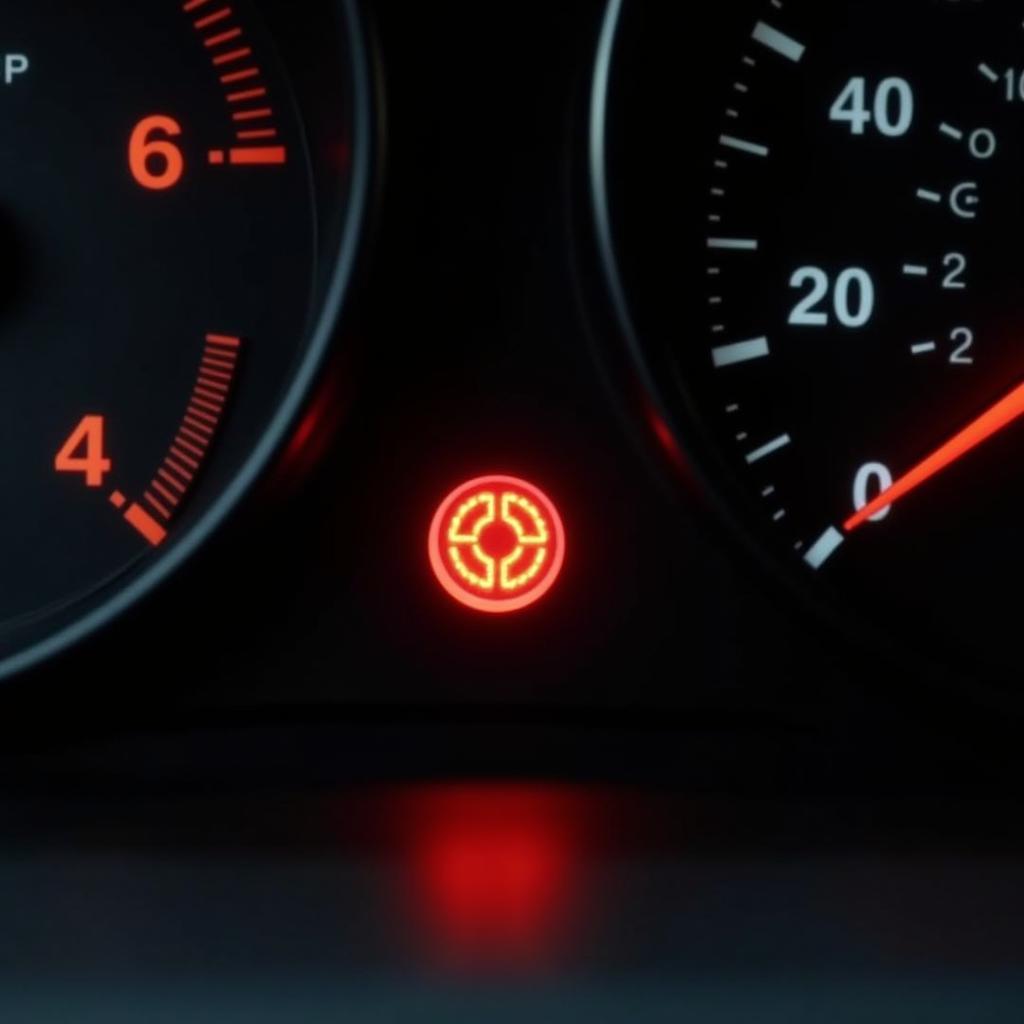The brake warning light on your dashboard is a crucial safety feature, and when it illuminates on your 2003 Ford Taurus, it’s signaling a potential problem with your braking system that shouldn’t be ignored. Understanding what this light means can help you address the issue promptly and prevent hazardous driving situations.
 2003 Ford Taurus Dashboard with Brake Warning Light Illuminated
2003 Ford Taurus Dashboard with Brake Warning Light Illuminated
Common Reasons Your Brake Warning Light is On
While the brake warning light is primarily associated with braking system issues, it can also indicate other problems with your Ford Taurus. Here’s a breakdown of the most common reasons:
1. Low Brake Fluid Level
The most common culprit behind a glowing brake warning light is low brake fluid. Your Taurus, like all vehicles with hydraulic brakes, uses brake fluid to transmit force from the brake pedal to the wheels, enabling stopping. A leak in the system can lead to a drop in fluid level, triggering the warning light.
What to do: Check the brake fluid level in the reservoir under the hood. If it’s low, add the recommended brake fluid for your 2003 Ford Taurus. However, simply topping off the fluid won’t fix a leak. It’s crucial to have your braking system inspected for leaks by a qualified mechanic as soon as possible.
2. Engaged Parking Brake
It might seem obvious, but sometimes the simplest answer is the right one. If your parking brake is even slightly engaged, it can trigger the warning light. This is a safety feature designed to remind you to disengage the parking brake before driving.
What to do: Check if your parking brake is fully released. If not, disengage it completely. The warning light should go off once the parking brake is fully disengaged.
3. Worn Brake Pads
Your brake pads are designed to wear down over time. They create friction against the brake rotors to slow down and stop your vehicle. When the pads wear thin, a sensor sends a signal to illuminate the brake warning light, indicating it’s time for a replacement.
What to do: Have your brake pads inspected by a mechanic. If they are worn down, they’ll need to be replaced. Ignoring worn brake pads can lead to costly damage to your rotors and significantly reduce your braking efficiency, jeopardizing safety.
4. Faulty Brake Light Switch
Your brake lights and brake warning light are often connected through the same switch. If this switch malfunctions, it can prevent your brake lights from illuminating when you press the brake pedal and trigger the warning light on your dashboard.
What to do: Have a mechanic inspect your brake light switch. If it’s faulty, it will need to be replaced to ensure both your brake lights and brake warning system are functioning correctly.
 Mechanic Checking Brake Fluid in a Ford Taurus
Mechanic Checking Brake Fluid in a Ford Taurus
Other Potential Causes
While less common, other issues can also lead to an illuminated brake warning light in your 2003 Ford Taurus:
- Faulty ABS System: Issues within the Anti-lock Braking System (ABS), such as a malfunctioning speed sensor, can trigger the warning light.
- Master Cylinder Problems: The master cylinder is responsible for distributing brake fluid pressure. A malfunctioning master cylinder can cause brake failure and illuminate the warning light.
- Electrical Issues: Problems with wiring, connectors, or the instrument cluster itself can cause false readings, including a faulty brake warning light.
“Ignoring your brake warning light is like driving with your eyes closed,” says John Davis, a seasoned automotive engineer with over 20 years of experience. “It’s crucial to diagnose and address the problem immediately to ensure your safety and the safety of others on the road.”
What to Do When Your Brake Warning Light Comes On
If your brake warning light comes on, it’s crucial to take immediate action:
- Pull Over Safely: Find a safe place to pull over as soon as possible.
- Check Your Parking Brake: Ensure your parking brake is fully disengaged.
- Inspect Brake Fluid: If it’s safe to do so, carefully check your brake fluid level.
- Seek Professional Help: If the brake fluid is low or you suspect any other issue, do not attempt to drive further. Contact a qualified mechanic to diagnose and repair the problem.
Remember, your brakes are your vehicle’s most important safety feature. Don’t ignore any warning signs that indicate a problem. Regular maintenance and prompt attention to warning lights can save you from costly repairs and potential accidents.
2003 ford taurus brake light warning
FAQs
Q: Can I drive with my brake warning light on?
A: It’s not recommended. Driving with a brake warning light can be extremely dangerous. Pull over safely and have your vehicle towed to a mechanic.
Q: How much does it cost to fix a brake warning light issue?
A: The cost can range significantly depending on the underlying problem. A simple brake pad replacement will be less expensive than a faulty ABS system repair.
Q: How often should I check my brake fluid?
A: It’s a good practice to check your brake fluid level at least once a month and have your braking system inspected annually.



